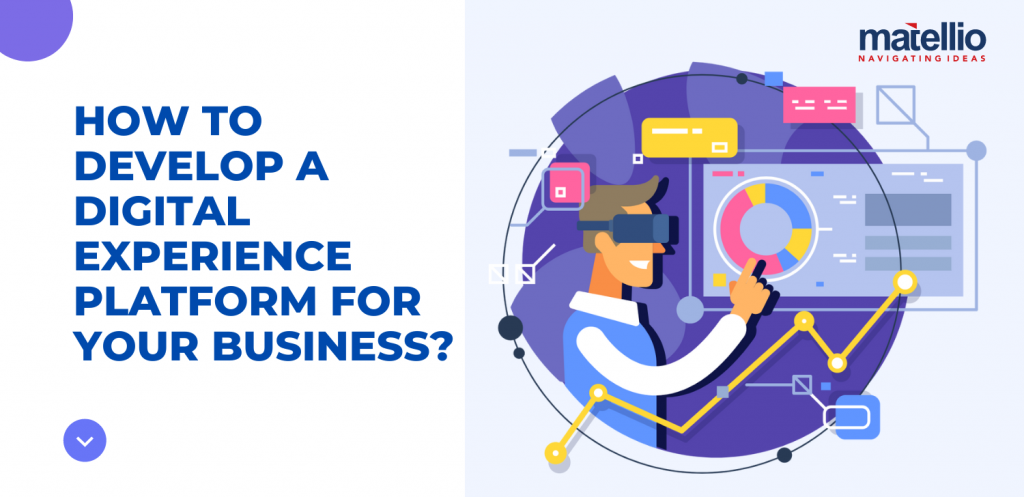
In today’s age of digital transformation, providing a seamless customer experience has become the key to success. Gone are the days when businesses could rely on traditional methods of marketing and sales, as today’s consumers demand an integrated, personalized, and accessible experience across all digital channels. Today users have an average of 3.4 devices, and they use all of them to access the websites and apps they would want to make a purchase from. Furthermore, the customer journey, too, has become more complex than the simple linear flow of search-website conversion. Consumers today step in and out of the traditional journey before they make a final purchase. All these factors prove that an omnichannel customer experience is the most competitive factor a business can hope to have, and today’s topic is about the platform that facilitates the same.
Digital Experience Platform: Overview and Evolution
A Digital Experience Platform (DXP) is a software suite designed to be a one-stop solution for creating, managing, and measuring the success of a company’s digital communications, commerce, and experiences. It provides a robust ground for aligning sales, marketing, commerce, product, and service teams, where every single touchpoint and type of customer experience can be managed in one place. DXP solutions allow for building meaningful applications that can be integrated and optimized across various digital touchpoints and backend systems, allowing seamless interactions between customers and businesses.
Prominent digital experience platform examples include Bloomreach, Acquia, Salesforce Experience Cloud, and Adobe Experience Manager. These platforms assist customers with well-thought-out, personalized digital experiences while offering businesses an opportunity to enhance their performance. Other than these pre-built solutions, businesses with existing IT infrastructure can have custom DXPs built through dedicated enterprise software development services. This will help them get tailored API-integration functionalities to add out-of-the-box feature sets to their solutions. These will help them to build the right solution for their business by adding elements from various verticals. In the end, they can completely eliminate organizational siloes in order to create a truly omnichannel experience for every customer.
How DXPs Became the Sole Digitalization Solution of The Era?
The competitive landscape set by the global digital transformation of all businesses has made it essential for them to have the right tools in place to drive digital transformation for themselves. The modern digital experience platform is the result of years of technological evolution and industry-spanning digital transformation; they’re the descendants of older content management systems (CMS) and web experience management systems (WEM).
Content management systems have been used since the early days of digital publishing, allowing editors and site owners to upload static text and images. These systems are still used today, but their limitations become clear when brands start to link their different marketing touchpoints, like their website, email, social media, search engine, and more, to create linear marketing journeys.
Enters web experience management systems, the direct successors of the content management system concept. These systems brought in the ability to track user data and behavior across owned and third-party channels, including social media platforms, CRMs, and Email marketing funnels. As such, these systems were able to help businesses build audience profiles and provide more personalized marketing services to them. However, they were still not integrated enough to relay this information seamlessly across teams and departments.
This is where Digital Experience Platforms’ needs were felt. With marketing done right, prospects were ready to be treated with as much personalization as they had been treated throughout their acquisition procedure. However, businesses had no tools to meet such expectations. They were in a dire situation to salvage their prospects from the bottom of the marketing funnel and add them to their loyal customer base. With digital experience platforms, they can now integrate every tool, technology, and service that can help them create better experiences for customers, employees, and partners. This includes tools for personalization, content management, analytics, marketing automation, customer service, commerce, and more.
Benefits of Developing a Custom Digital Experience Platform
Now the major benefit of a DXP is the seamless digital experience for all, and this is something that any major DXP present in the market can offer. However, when it comes to a tailored solution for a business, most of them still have certain limitations. Many of them feature many functionalities that can make the interface complex for small-scale businesses. Similarly, for bigger enterprises, these platforms present many scalability issues. As such, investing in developing a custom Digital Experience Platform can help you achieve all the benefits of a DXP without having to deal with any of its limitations. Some of the other major benefits of building a custom solution for a DXP include the following-
- No pre-built solution can help businesses meet all their requirements in the way they prefer. The same is true with DXPs. A custom DXP can easily be developed to meet the specific needs and goals of a business rather than trying to fit into a one-size-fits-all solution.
- While all the major DXPs are trying to achieve everything with one platform, they miss out on touching the particular requirements a customer would have from a niche business. In contrast, a custom platform can provide a more seamless and personalized user experience, increasing engagement and satisfaction.
- A tailored digital experience platform can be designed to evolve and scale with the changing needs of a business. This provides greater flexibility for businesses of all sizes, helping them future-proofing their entire tech ecosystem.
- Many existing DXPs were built to integrate siloed systems by embedding well-known software of different departments. However, in reality, most businesses are still working with legacy software, which may not be as easily integrated. As such, custom platforms remain the best solution, allowing businesses to build a more integrated and efficient technology ecosystem.
- Last but not least, a unique and innovative digital experience platform can give a business a competitive advantage. They can set businesses apart from the other competitors in the industry that are relying on the limited functionalities of a pre-built solution, paying an additional amount for them in the long run too.
Also Read: How Much Does Digital Transformation Cost?
Steps to Develop a Custom Digital Experience Platform
Since DXPs are enterprise-grade software solutions on which the digitalization of your entire organization depends, you must build it using best practices and a sophisticated approach. Such an approach allows you to leverage the latest technologies and trends to create a robust and reliable platform that stays tailored to your users’ specific needs. Furthermore, it also ensures that you have a high level of control over the entire user experience, allowing you to optimize it for maximum engagement and customer satisfaction.
Identify Your Target Audience
The first step in building a custom DXP is to identify your target audience so that you can build a platform that meets their expectations and needs. To know your target audience, you must first understand how you are going to restructure your organization while transforming it with digitalization. If you’re only digitalizing the marketing and sales aspect of your business, those two will remain your primary personas. However, for businesses looking for comprehensive digital transformation, every department, including marketing teams, IT departments, product teams, customer service reps, and business analysts, all are going to need a dashboard and functionalities for their respective purposes.
Assess User Needs and Preferences
Assessing user needs and preferences is an important second step in developing a DXP, as this will define the feature and functionalities the custom platform is supposed to have. For example, your marketing team will be using the platform to create, manage, and deliver personalized digital experiences to customers across multiple channels and devices. Similarly, the product development teams will use the data and insights generated by the platform to make better-informed product design and development decisions, ensuring that products meet the needs and preferences of customers. The customer support department would usually utilize the DXP to provide more personalized and efficient support to customers. At the same time, sales and business analysis teams will use it to create better sales strategies and tactics and identify opportunities for growth and efficiency.
Evaluate Current Technology Infrastructure
Once you have a clear understanding of who will use the custom-built DXP and how they will use it, you can go ahead and conduct an extensive evaluation of your current technology infrastructure. This step is crucial to determine what systems and applications are already in place and how they can be integrated with the DXP to ensure compatibility and seamless operation. It will also help in ensuring whether the existing system has the capacity to support the implementation of a DXP, including hardware and software requirements, network connectivity, and data storage capacity. To carry out such a deep analysis, you will have to perform an inventory of all the existing systems and check how scalable they are and whether and how they can be integrated.
Choose Key Features of a DXP
Choosing features to develop for a digital experience platform can be a challenging task, as there are many different factors to consider. From current infrastructure in the organization and business need to industry standards and trends, all these factors can easily overwhelm you from making this key decision. The best option here is to evaluate the different features existing DXPs are offering. You can then pick the ones that fit your requirements and disregard all the rest. You can then conduct department-wise surveys to understand which functionalities yet remain untouched from the list of selected features. This is where customization will happen to make your DXP one of a kind and the best fit for your business. That being said, all DXPs must have some common features to fulfill their purpose, and the major ones among them are mentioned below-
Personalization
Since this is the foundation of the concept, your custom DXP must have the ability to deliver personalized experiences to customers based on their preferences, behaviors, and context. This can be achieved through data analysis, machine learning algorithms, and customer profiles. Personalization can be applied to various aspects of the digital experience, such as content recommendations, product recommendations, and personalized messaging. The goal of personalization is to create a more engaging and satisfying experience for customers, leading to increased customer loyalty and conversion rates.
Content Management
A robust content management system will allow your content teams to easily create, manage, and publish high-quality digital content through an intuitive interface. A good CMS will also have the ability to manage multiple sites and channels from a single platform and should provide tools for optimizing content for search engines.
Workflow Management
This feature should provide an intuitive interface for defining and managing workflows, such as approval workflows, content publishing, and user access controls. It should also allow for the automation of certain processes, such as content approvals and notifications, to save time and improve efficiency. The goal of workflow management is to ensure that work is completed accurately, efficiently, and in a timely manner, with minimal manual intervention. By automating routine tasks and streamlining processes, businesses can focus on higher-level tasks, leading to improved productivity and efficiency.
Customer Data Management
For a DXP to facilitate a truly omnichannel experience, it must have a system for collecting, storing and managing customer data, including demographic, behavioral, and transactional data. It should also provide tools for analyzing and segmenting this data to gain insights into customer behavior and preferences. This system should be easily integrated with other systems, such as marketing automation and analytics, to enable more personalized and effective communication with customers. The goal here is to provide businesses with a comprehensive understanding of their customers, so they can improve engagement and conversion rates and build stronger relationships with their customers.
Omnichannel Delivery
The Omnichannel Delivery feature enables businesses to deliver consistent digital experiences across multiple channels, including web, mobile, social media, and offline stores. It ensures that the customer experience stays consistent and seamless at all touchpoints. It should also allow for real-time synchronization of data across channels, such as cart contents and customer information, to provide a truly seamless experience. This will help businesses increase customer loyalty and drive revenue growth through increased average order value and the lifetime value of every acquisition.
Also Read: Ultimate Guide to the Omnichannel Customer Experience
Enterprise Mobility
To make digital experience platforms more usable and contemporary to present needs, they should also support mobile use. Today’s workforce prefers to have seamless access to their work resources, enabling them to work remotely as and when they like. Moreover, most businesses have at least one of their departments usually working on the go. Mostly, this department is the sales department, which also needs to stay connected to the organization’s DXP the most. As such, investing in mobile app development services is an ideal solution, so you can enable your entire workforce to stay connected ceaselessly.
Analytics and Insights
Advanced analytics and reporting capabilities in a DXP platform provide businesses with real-time insights into customer behavior and engagement. This enables businesses to track and analyze key metrics, such as website traffic, conversion rates, and customer engagement. The feature should also entail the creation of custom reports and dashboards to provide a clear and concise view of key metrics.
Marketing Automation
Automated marketing capabilities, including email, SMS, and push notifications, in a DXP marketing module will allow businesses to communicate with customers in a targeted and personalized way. Automation of messages will help businesses to reach out to customers in a timely and relevant manner. Through targeted campaigns based on customer behavior and preferences and tools for testing and optimizing these campaigns, marketing teams can enhance their efforts against investment multifold. Additionally, by automating routine marketing tasks and delivering targeted and personalized experiences to customers, businesses can improve the productivity of their marketing efforts, achieving way more than what they would have if they were using traditional approaches.
Customer Service
An integrated customer service platform that provides customers with support and assistance through multiple channels, including live chat, phone, and email, is the key feature of a robust DXP platform. It provides customer service teams with an integrated platform to efficiently manage and respond to customer inquiries and requests in the medium they prefer. By adding the functionality to prioritize and route customer inquiries to the appropriate team, the entire process can get further streamlined. This will help the team aid customers with quick and effective support. Its direct effect will reflect on customer satisfaction rates which in turn will reduce churn and increase customer loyalty.
Integration with Existing Systems
A custom DXP must be able to integrate with existing systems and applications, such as CRM and ERP systems, to ensure seamless data exchange and operation. The integration should allow for bi-directional data exchange, so that information can be passed between the custom DXP and other systems in real time. It should support a variety of data formats so that businesses can easily transfer data between different systems, regardless of the underlying data structure or format. This will help businesses avoid data duplication and improve its accuracy. It will also help them increase the efficiency and effectiveness of their digital experiences.
Security and Compliance
Since DXPs primarily function on customer data, ensuring data privacy and compliance is crucial. This is why your custom DXP must take robust security measures, such as encryption, access controls, and secure data storage, to protect customer data from unauthorized access and theft. It also should ensure that the data modeling and communication protocols are compliant with industry standards and regulations, such as the General Data Protection Regulation (GDPR) and the Payment Card Industry Data Security Standard (PCI DSS). By prioritizing security and compliance, businesses can increase customer trust, reduce the risk of data breaches, and minimize the potential impact of security incidents.
Developing a Project Plan
For a project as extensive and complex as that of DXP, you definitely need a development plan so you can develop, test, deploy, and integrate your DXP in smaller steps allowing changes to gradually get implemented in your organization. To begin with, you must document all the features and functionalities expected of the platform. Then, design the overall architecture of the DXP platform, including the technology stack, integration points, and data flow. Later, you can develop modules and features for different user personas and release those prototypes for User Acceptance Testing. In many sprints, you will get the deployable product that you can start integrating and testing iteratively. To simplify this process, you should instead hire an enterprise software development company, which can take care of the entire process for you.
Hire Technical Skills
With the project plan ready, you should begin hiring professionals with extensive experience in developing digital experiences or other relevant enterprise software. With their expertise, you can create an engaging experience for your users and ensure that the final product will be tailored to the needs of your organization. To further bring more reliance into the development lifecycle, you should take staff augmentation services from a company with long years of experience. Hiring skills from them is an excellent way to ensure that the final product meets the highest standards in the pre-meditated budget and timeline. Some key roles you would require for your project would be web and software developers, UX designers, database administrators, system administrators, DevOps engineers, and QA engineers. Now depending on the urgency and complexity of the product, you can hire as many or as fewer of these professionals as best fits your requirements.
Deploy the Platform
To successfully and reliably deploy a DXP on your organization level, you must first release it on a staging server. For that, you first need to set up a staging environment that mirrors the live environment you plan to deploy your DXP. This will allow you to test the deployment process and identify and address any issues. Once you have successfully implemented the platform on a staging server, you can begin the actual deployment by backing up all of the existing data from different legacy software. With that done, you can finally install the DXP software on the production environment and make configurations as per user needs. You can then slowly but effectively integrate all the systems and test the flow of information against expectations. For this purpose, you can also invest in hiring DevOps consulting services, which help you deploy the digital experience platform in a more sophisticated manner.
How Can Matellio Help with Custom DXP Development?
Developing a custom digital experience platform for your business can be a highly beneficial investment. By creating a tailored solution that meets specific needs and requirements, businesses can enjoy a more efficient and effective digital experience. A custom DXP can provide improved user experience, increased productivity, better collaboration and communication, enhanced security, and the ability to integrate with existing systems and technologies.
That being said, developing a custom DXP for your business from scratch is a difficult task that requires a significant amount of time, effort, and money. It requires in-depth knowledge of coding, digital marketing, and the ability to manage complex projects. This is why most businesses choose to outsource the development of their digital experience platform to experienced professionals. If you, too, are considering hiring a software development company for this purpose, Matellio would be the best answer for you.
Matellio is a technology and digital transformation services provider that has been helping businesses with custom development and consultation solutions for over a decade. Our team of experienced developers and consultants can work with you to design, build, and deploy custom DXP solutions that meet your specific needs and requirements. All you have to do to get to that stage is fill up this form with your requirements. Our experts will reach out to you with a solution and a free consultation call, so you can start your custom DXP’s realization journey as soon as possible.




